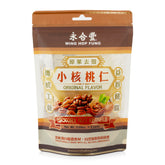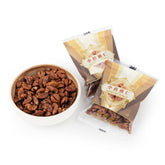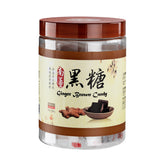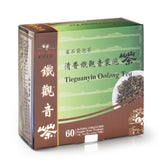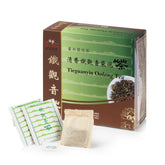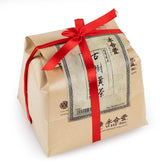Longjing Dragon Well Teas

Longjing or Dragon Well Tea received its name from a small village located at West Lake (Xi Hu) surrounded by tea mountains: Phoenix Mountain, Dragon Mountain and Lion Peak Mountain in Hangzhou. During the Three Kingdoms Period (221-280) residents of this area believed that a dragon lived in their village well and protected their crops by bringing abundant rainfall.
Emperor Qianlong of the Qing Dynasty (1644-1911) made a point of visiting the area to enjoy the local Dragon Well Teas each named for the mountain where they grew. During one of his visits while the Emperor was picking tea shoots, he received word that his mother, the Empress Dowager, was seriously ill, and he was requested to immediately return to Beijing. Alarmed, the Emperor Qianlong put the young tea shoots on his sleeve, and immediately sped back to the capital. Upon his return, while talking to her son, the Empress Dowager smelled the beautiful aroma of dry tea leaves coming from his sleeve and asked for the brewed tea. After drinking that tea her health was completely restored. Overjoyed by his mother’s recovery he designated 18 of the village's teas as producers of "Imperial Tea". This ensured Dragon Well Tea's famous reputation. The ancient tea trees are still alive today and have turned West Lake into a major tourist destination for tea lovers.
A Very Rare Tea
West Lake Dragon Well Tea is extremely rare. Zhejiang Province produces 15,000 tons of tea each year, and only 6% comes from West Lake. This is one reason for the high price of Dragon Well Tea. Another reason is the elaborate growing and processing necessary to produce the tea. Dragon Well Tea is made from tender tea shoots, not leaves like other teas. They are very small, no larger than 2 cm. One Kilogram of tea can have over 80,000 shoots.
The best Dragon Well Tea is picked very early in the spring. There is only a 6-week window to harvest them. The first two weeks of harvest are considered high grade, while the remaining four weeks are considered lower grade. Harvesting Dragon Well tea is much more complicated than simply plucking a few leaves from the tea plants. Timing, cultural techniques, and finesse are all key to the harvest and cultivation of Dragon Well tea. To ensure the best quality and flavor, this type of green tea is harvested before April 5th when the Qingming festival takes place. These teas are known as pre-Qingming or Ming Qian. The early harvest ensures that the tea is made only of the youngest and freshest tea leaves.
Since the tea mountains are covered with rain and fog in early spring, Dragon Well has the same healing benefits as other shade-grown teas such as Sencha and Matcha. Dragon Well green tea has higher concentrations of antioxidants and chlorophyll that boost healthy properties and flavor. In addition to higher levels of catechins, polyphenols, and amino acids, the tea also contains more caffeine than standard green teas.
Plucking, Withering, Roasting
The best Dragon Well tea is picked and processed by hand. A good tea picker can harvest only 2 kilograms of fresh leaves in a 10-hour day. Once the tea shoots are harvested, they must be roasted the same day. After picking the tea is "Withered". The tea is spread thinly to dry for 8 to ten hours. Doing this removes moisture and reduces any grassy, or bitter flavor. Once the tea is sufficiently dried, it is "Roasted". Roasting is done using bare hands to allow the roaster to feel his hands. It takes a novice many years to harden their hands so they do not suffer from the heat. It takes over 5 years to master the special hand movements required to dry the tea. A master roaster can only fry 1 kilogram of high-grade Longjing tea each day. After roasting the freshly processed Dragon Well tea is ready to drink.
Dragon Well Tea Taste
Because Dragon Well Tea is pan-fried it has a delicious chestnut aroma which should be high and lasting. The brewed tea is floral with an exceptionally long sweet aftertaste. The tea is often described as having vegetal base notes similar to spinach, enhanced by other flavors including chestnut and rich cream. Lesser teas often taste weak, grassy, or bitter. High-quality Dragon Well Tea will never have these features.
Types of Dragon Well Tea
There are three main types of Dragon Well tea and two additional varieties that are sometimes still classified as Longjing. The first three teas are known as Xihu Longjing teas — those that are grown in the West Lake area. The latter two are cultivated in the same province, but in Anji rather than Xihu, so traditional tea classifiers don't always consider them true Dragon Well teas even though they share many of the same flavor characteristics.
Meijiawu Dragon Well Tea. Nestled in the mountains of Xihu, more than 500 farmers cultivate an exquisite form of Dragon Well tea known as Mejiawu. What sets this Longjing tea apart from others is its rich jade green hue. The tea steeps a bright pale green liquor and offers nutty notes with a mildly floral aftertaste.
Shi Feng Longjing Tea. This Dragon Well tea is named after the mountain on which its tea leaves are harvested. Shi Feng (Lion Peak) one of five large mountains in this region of China. Its mild and foggy climate creates the perfect conditions for developing exquisite and expensive teas. This type of Longjing tea is the type historically enjoyed by emperors and is considered the highest quality Dragon Well tea. The tea brews into a light yellow hue and has a crisp flavor.
Tiger Spring Dragon Well Tea. Tiger Spring is another famous green tea from the West Lake region. This loose leaf tea is cultivated near the clear, refreshing Tiger spring. It is an expensive Dragon Well tea that can be infused numerous times without a decrease in flavor quality. It tends to be more mellow than Shi Feng with higher vegetal notes.
Bai Longjing. Bai Longjing is not a true Dragon Well tea as it is produced in Anji. In addition, this type of tea is actually made from a special type of white tea plant, although it is processed and sold as a green tea. The tea boasts a full body with grassy notes and is more affordable compared to the true Dragon Well teas.
Qiantang Longjing. This type of Dragon Well tea is cultivated outside of the West Lake region and is largely produced by the popular Chinese brand Shi, or Lion. A popular Longjing tea, it is more affordable and has nutty aromas and an aftertaste that is similar to sweet, juicy grapes. The tea leaves are an emerald green hue and brew into a rich green color when infused in hot water.
Dragon Well Tea Brewing Tips. For the best flavor, it's better to use filtered water or spring water instead of tap water. Like most green teas, Dragon Well tea should be brewed at lower temperatures than black tea or oolong tea, which can tolerate more heat. This type of green tea should be brewed with a water temperature between 170 and 180 degrees Fahrenheit (76 to 82 degrees Celsius). Bring water to a simmering boil and then let it cool for 2 minutes before pouring into your teapot for steeping. Dragon Well tea leaves can be infused 3 to 5 or more times before losing flavor. Set the leaves aside to brew multiple infusions, just make sure to increase the steeping time with each infusion by about 30 seconds.
Tea connoisseurs love the vegital notes, nutty undertones, and stunning green hues of Dragon Well tea. They also appreciate the layered flavor profile of this Chinese green tea and the rich history of the growing region that makes these authentic and rare teas. By far the highest quality Dragon Well teas come from the West Lake area (Xihu) of Zhejiang..
Hangzhou is famous for its gorgeous scenery, stunning sites, Dragon Well Tea and unique culture. The most famous attraction in Hangzhou is the West Lake, an area of over 60 square kilometers, surrounded by stunning scenery and plenty of cultural relics. West Lake is surrounded on three sides by tea mountains. Many classical poems have been written to praise the beauty and serenity of West Lake. Here is one:
Spring Theme: Above the West Lake 'Chun ti hushang' 春題湖 — Bo Juyi
Now spring is here the lake seems a painted picture,
Unruly peaks all round the edge, the water spread out flat.
Pines in ranks on the face of the hills, a thousand layers of green:
The moon centered ion the heart of the waves, just one pearl.
Threads of an emerald-green rug, the extruding tea shoots:
Sash of a blue damask skirt, the expanse of new reeds.
If I cannot bring myself yet to put Hangzhou behind me,
Half of what holds me here is on this lake.
Shop Now!

